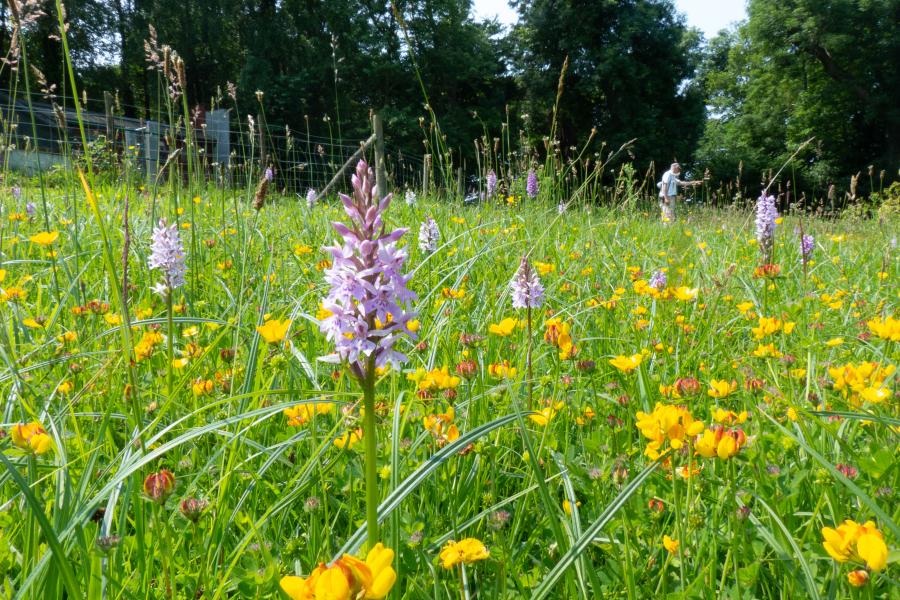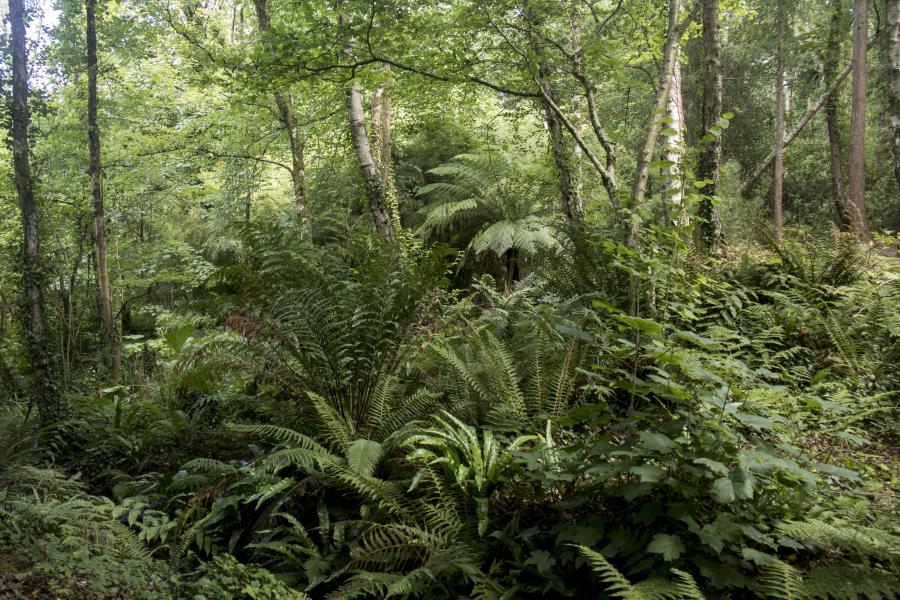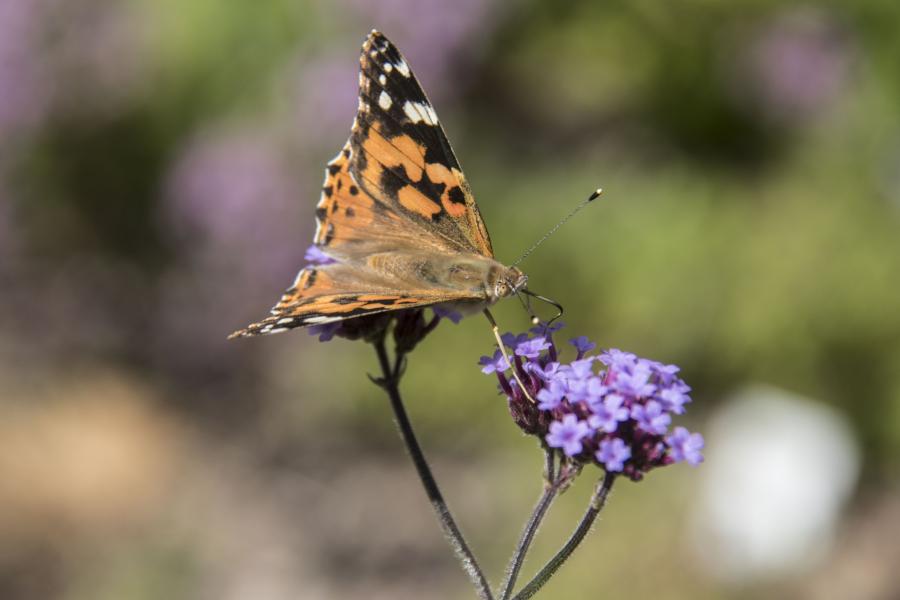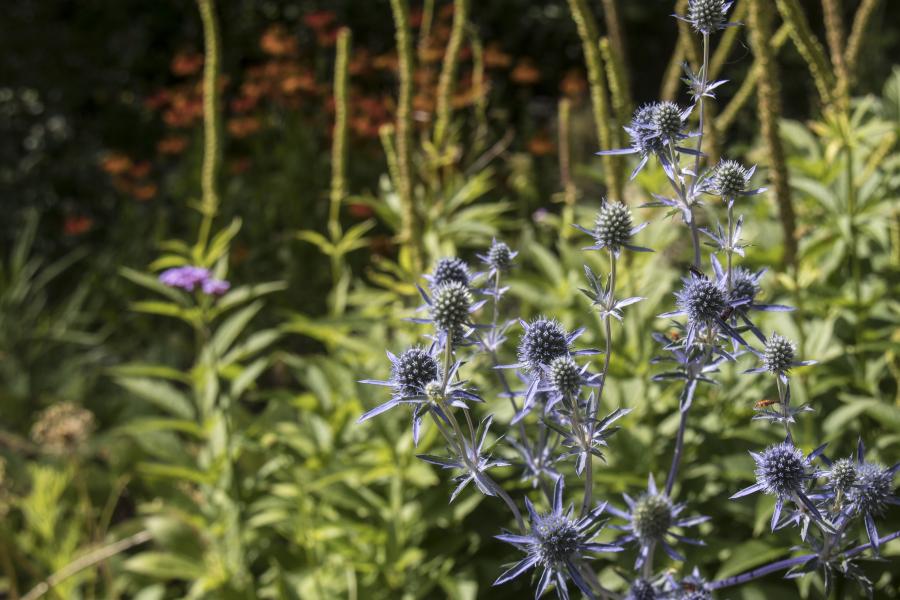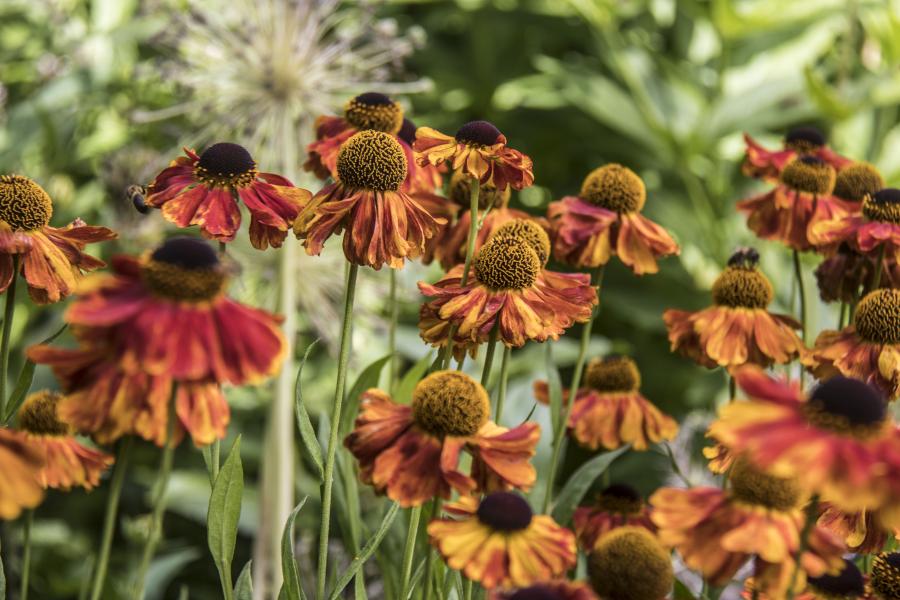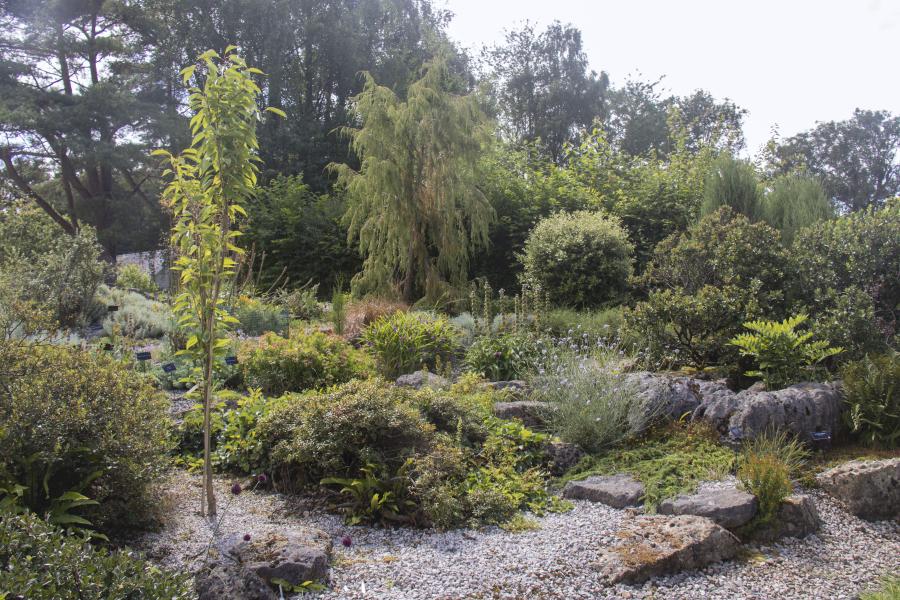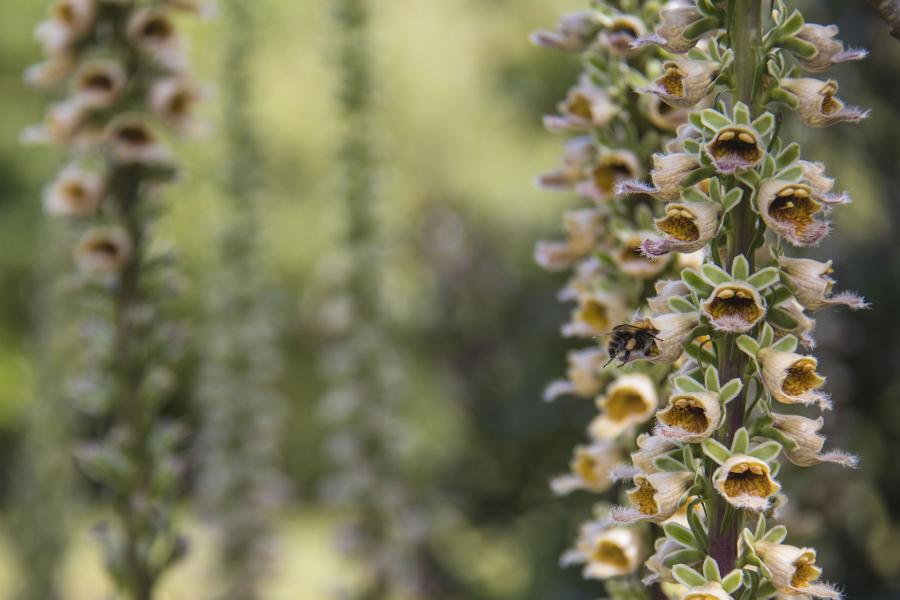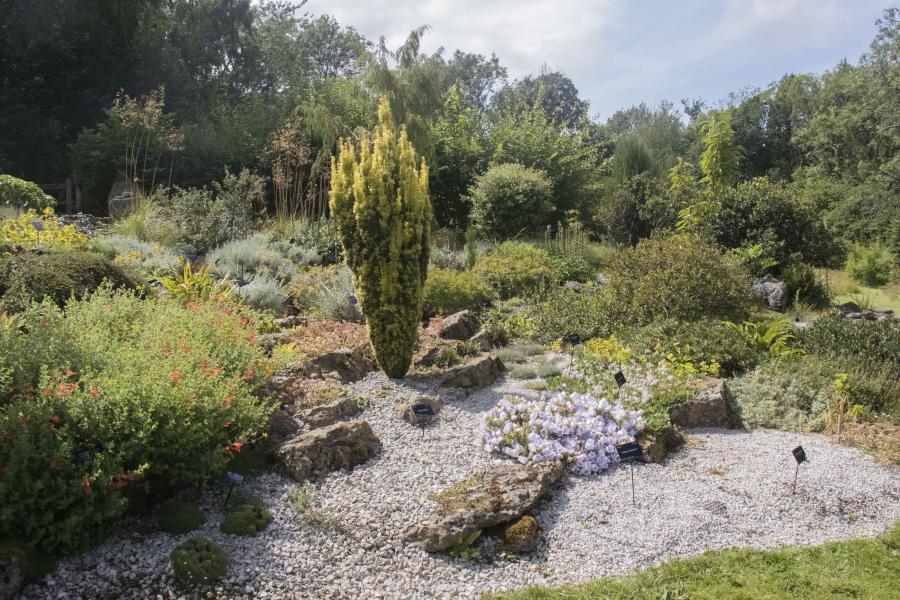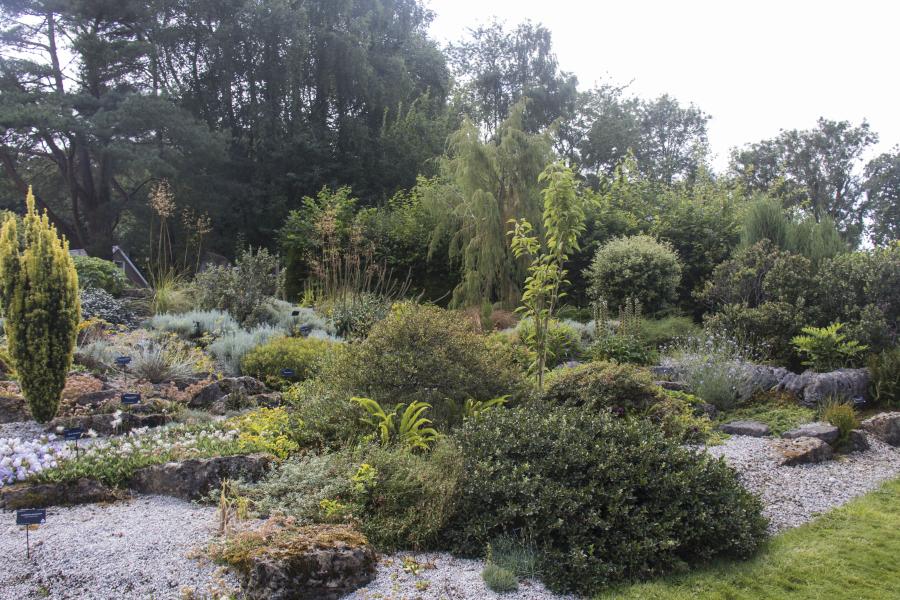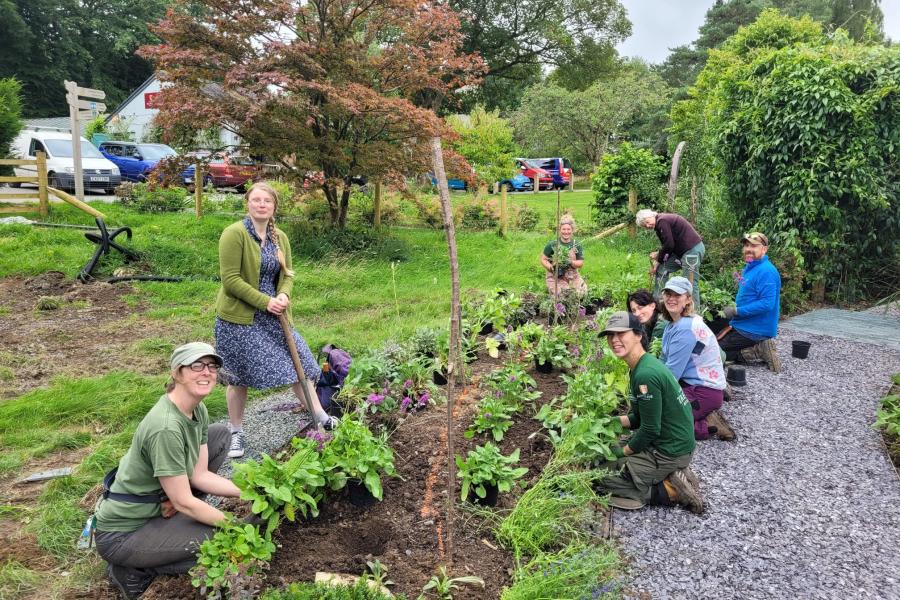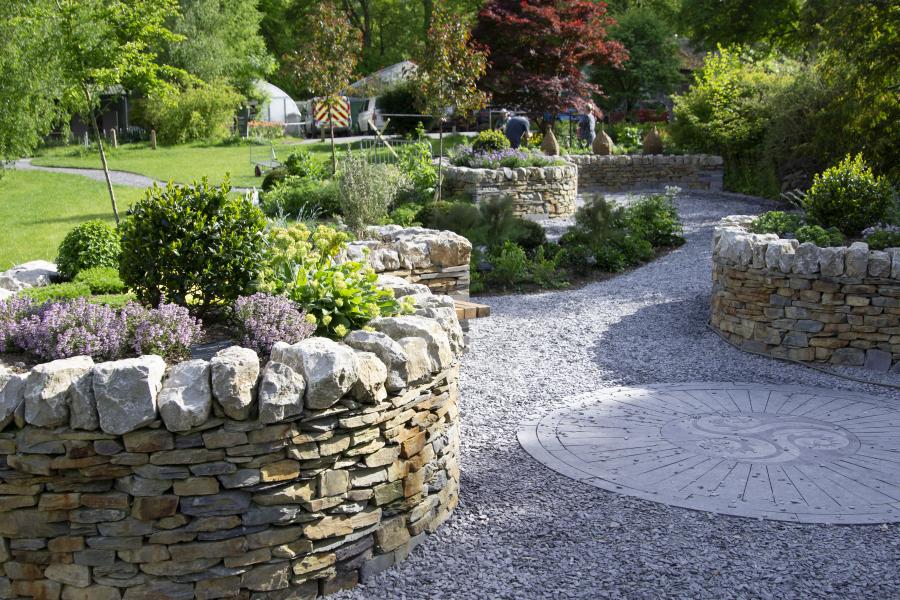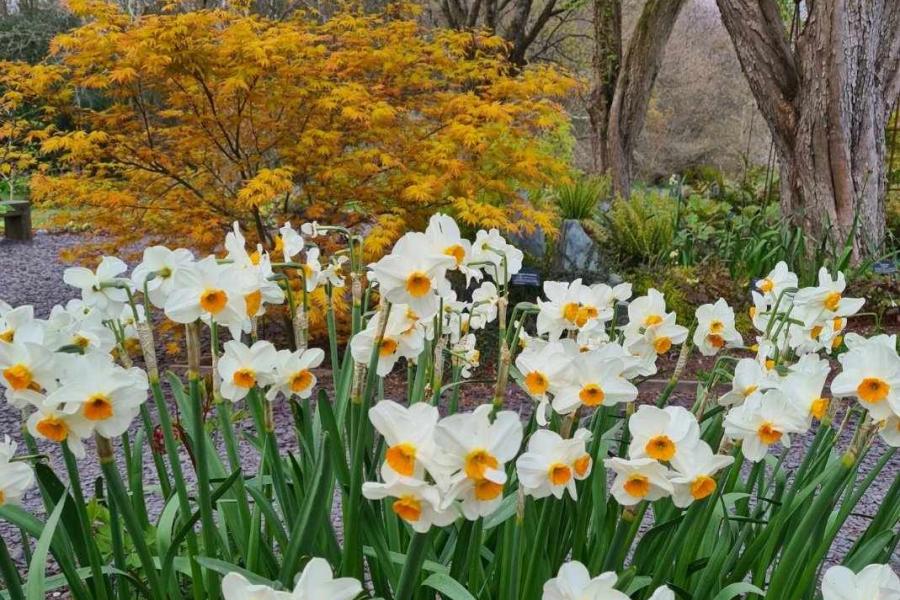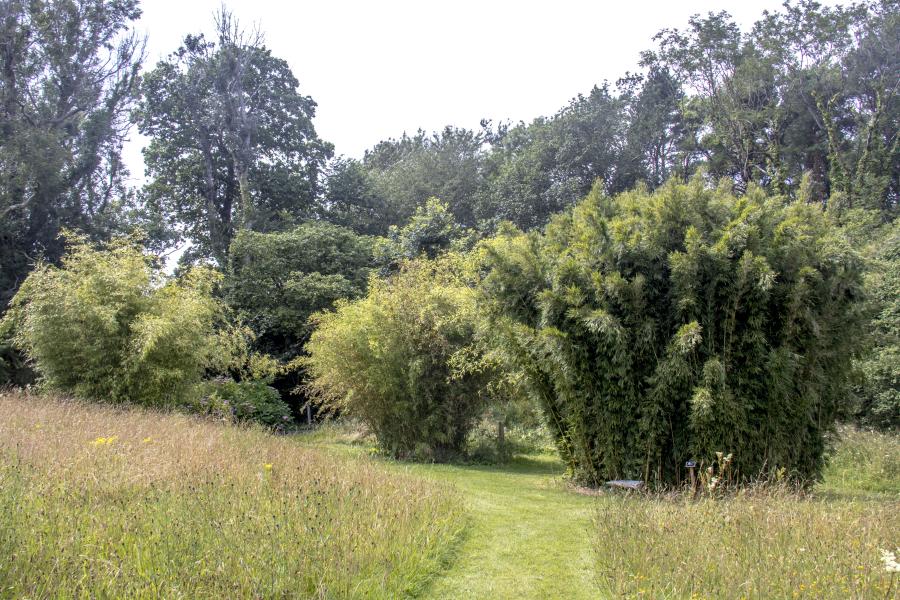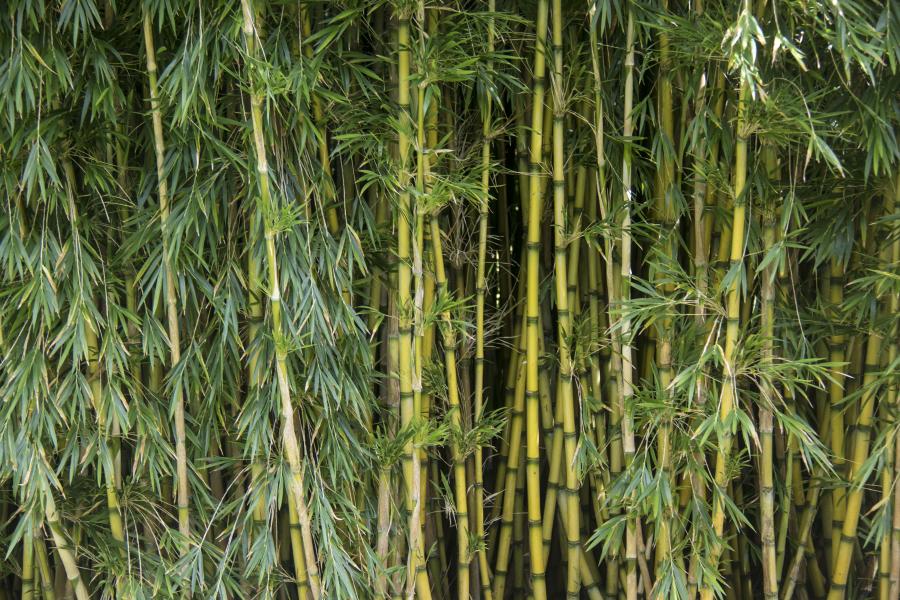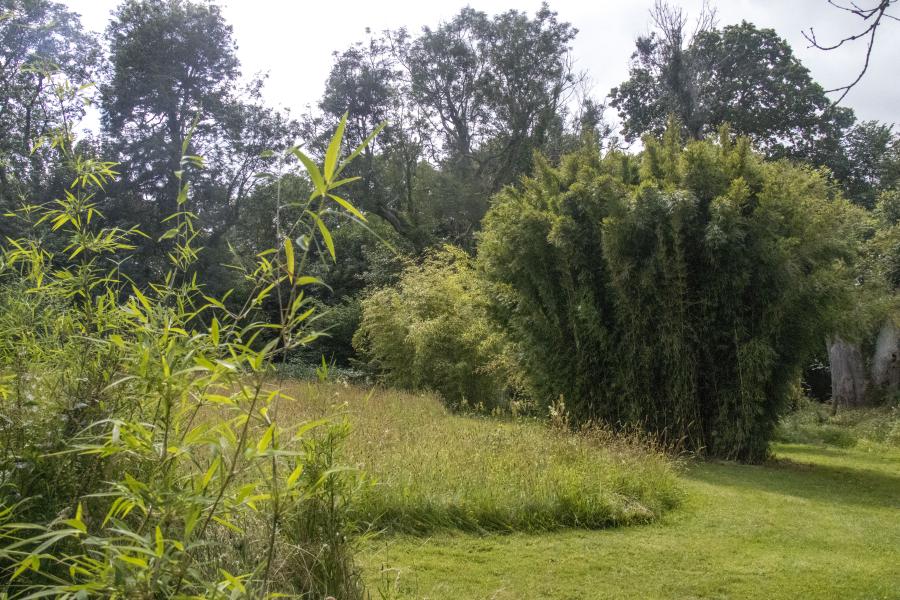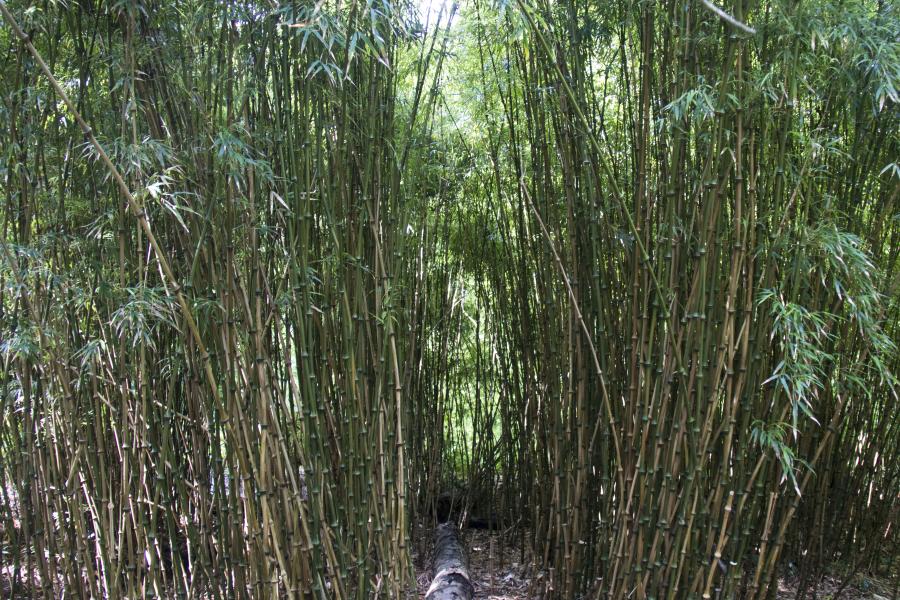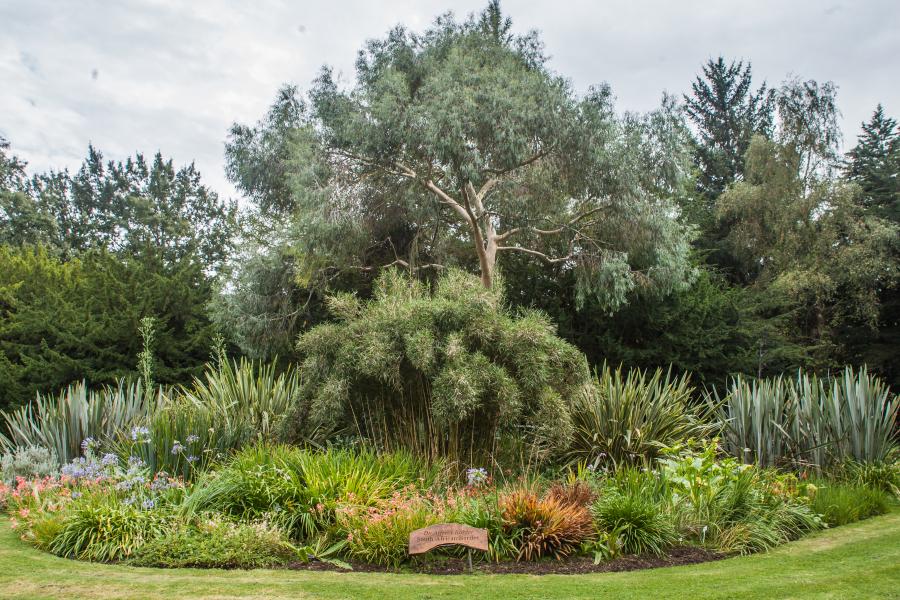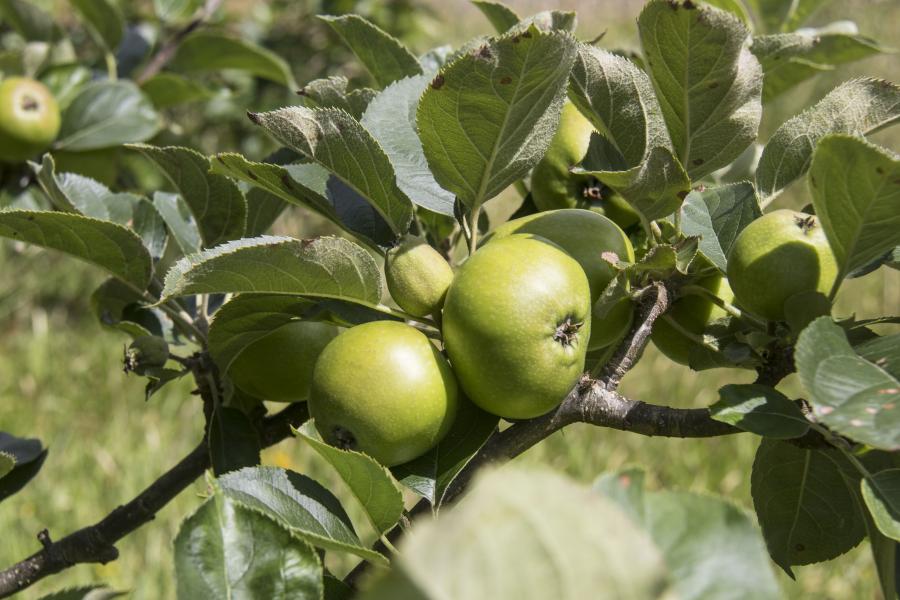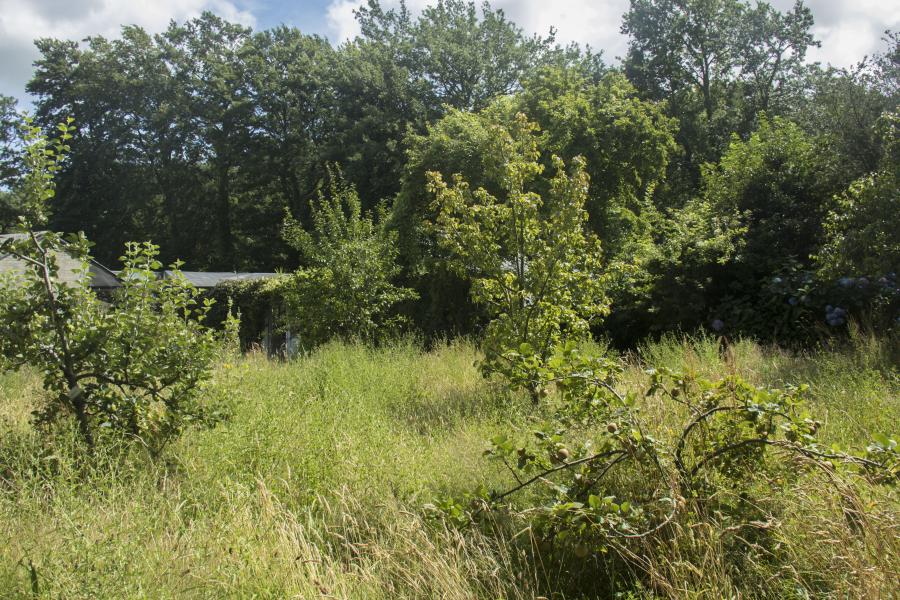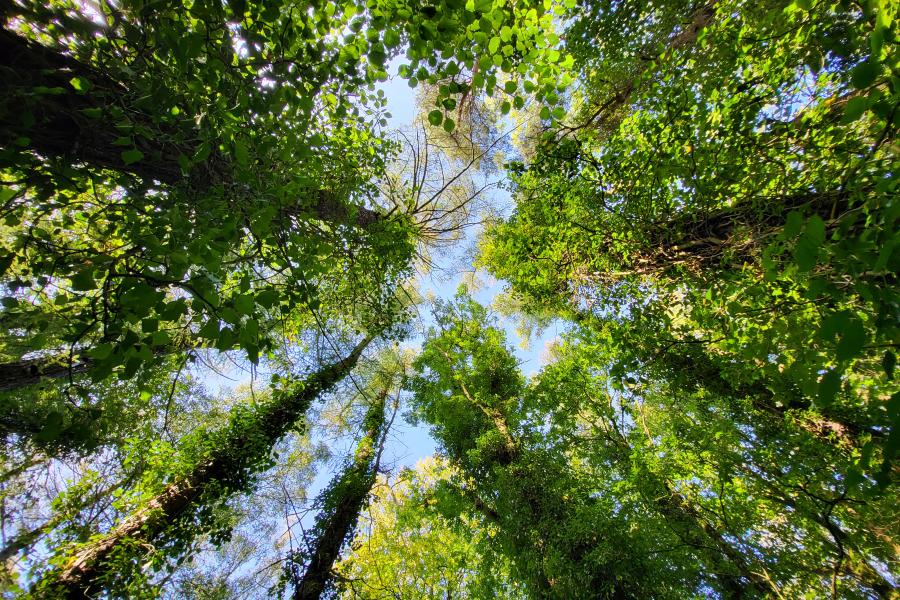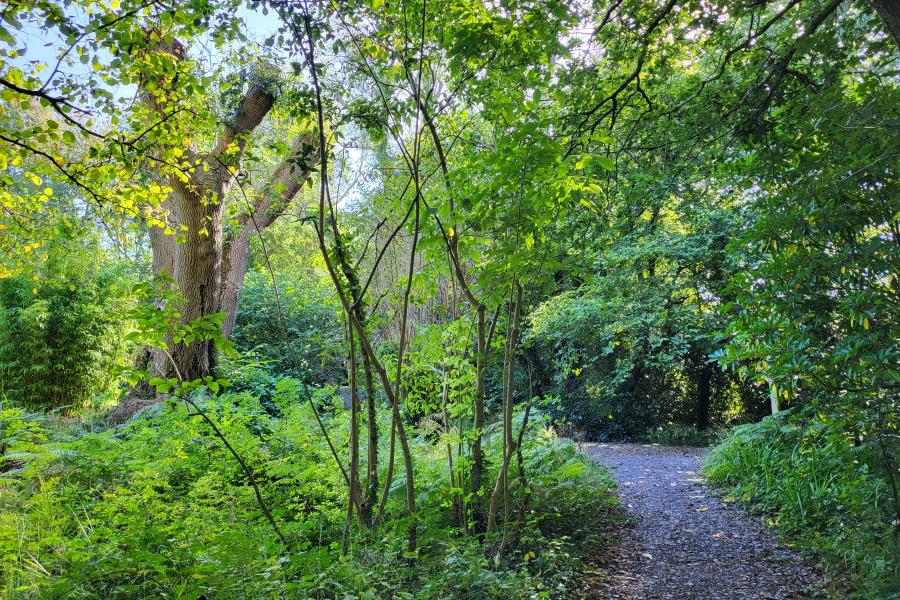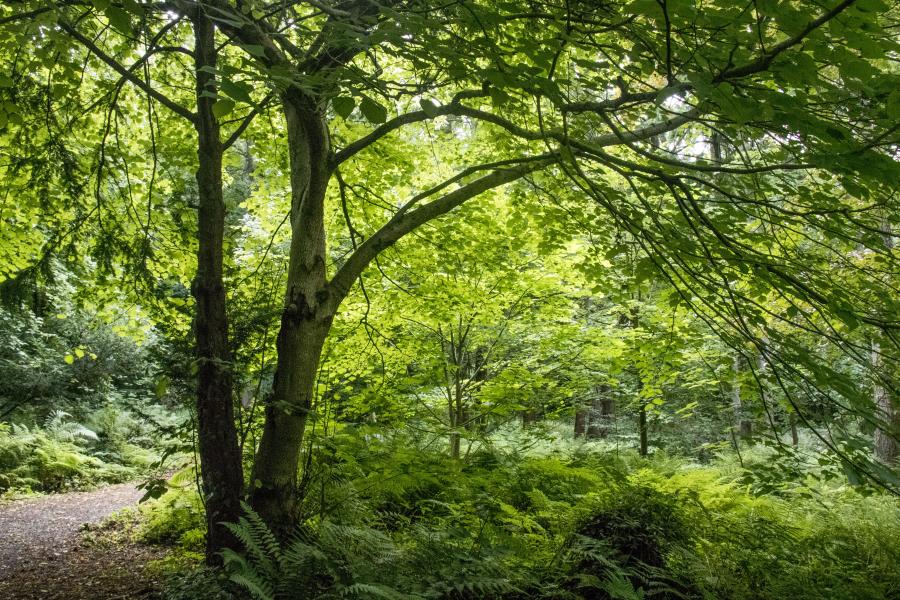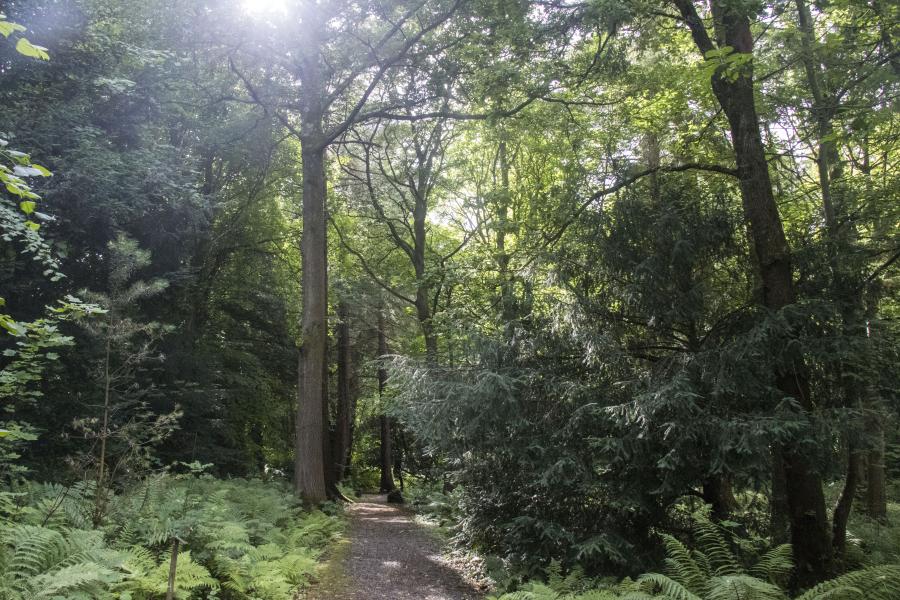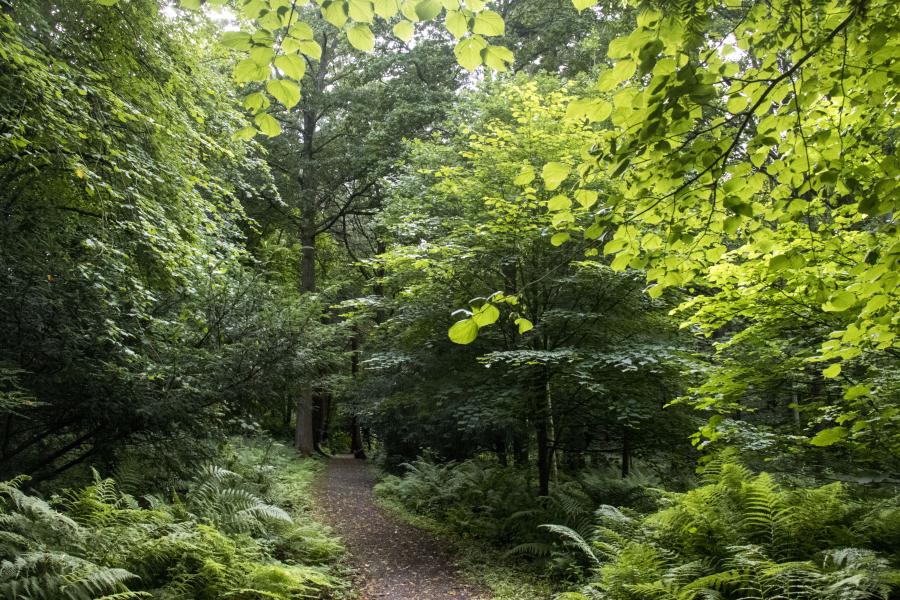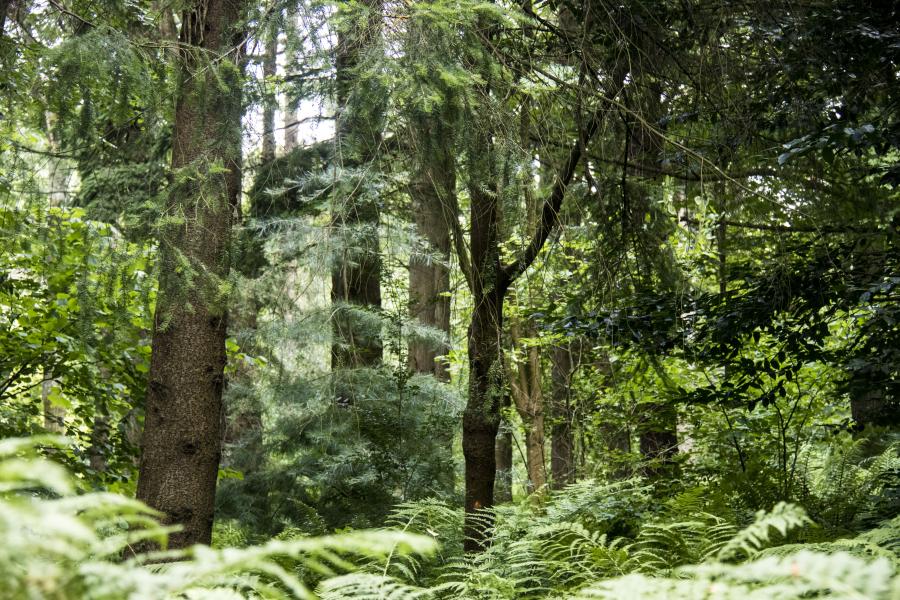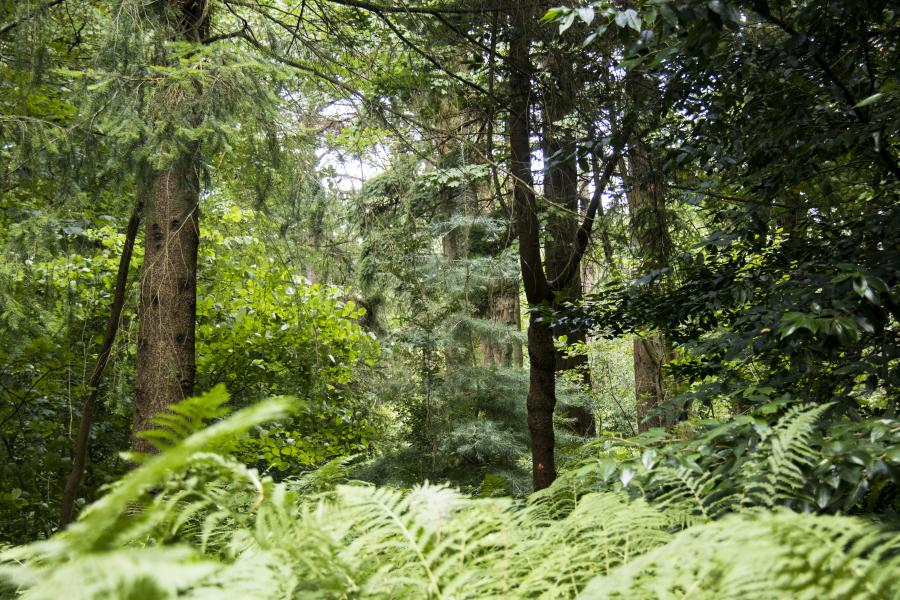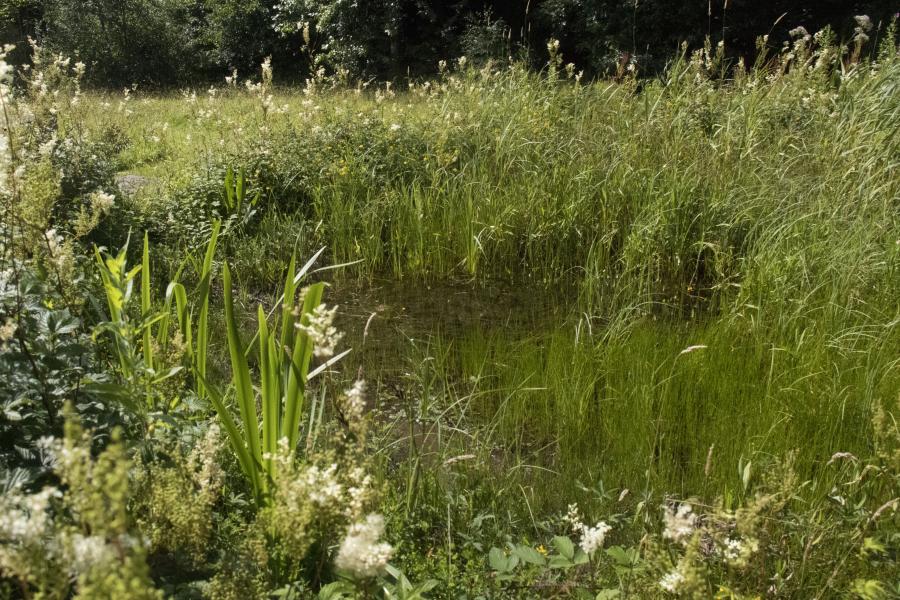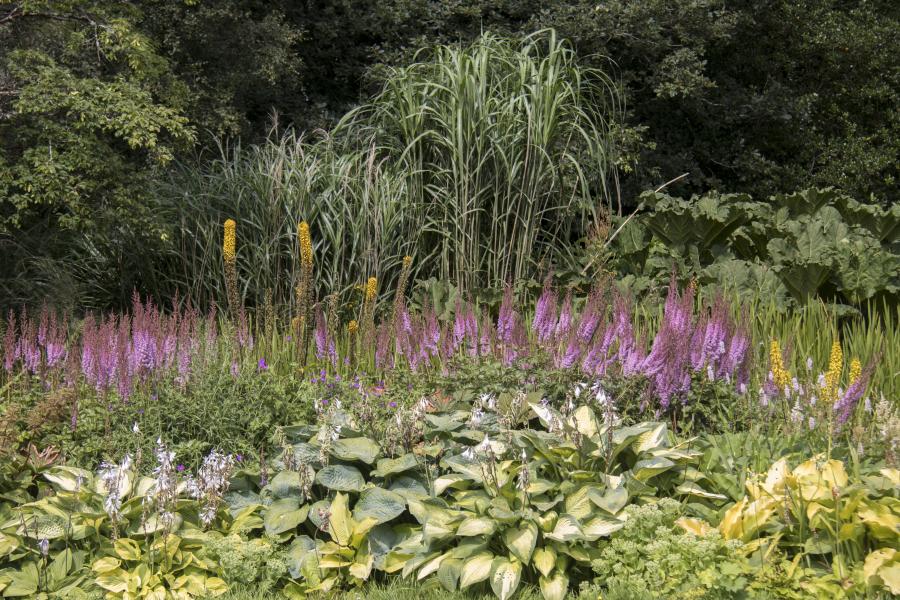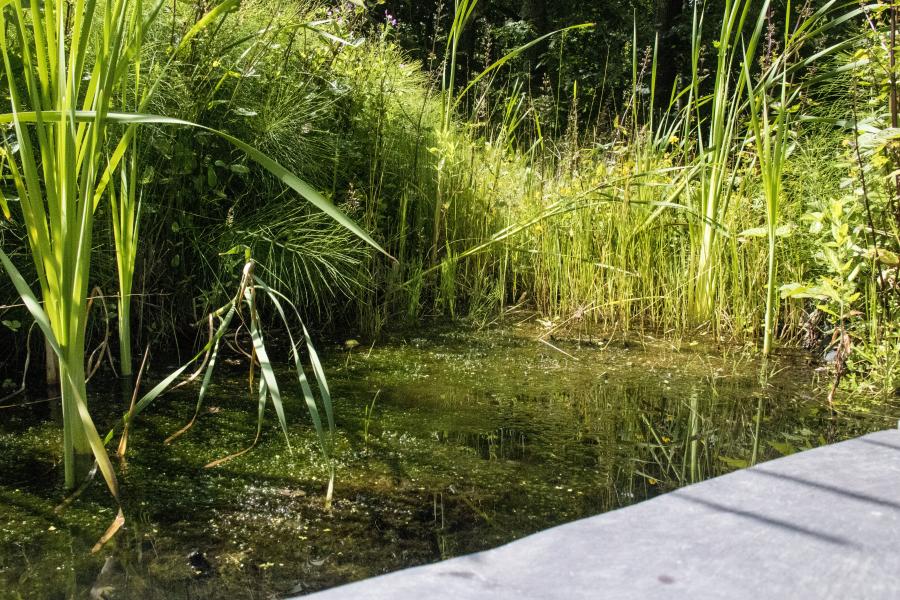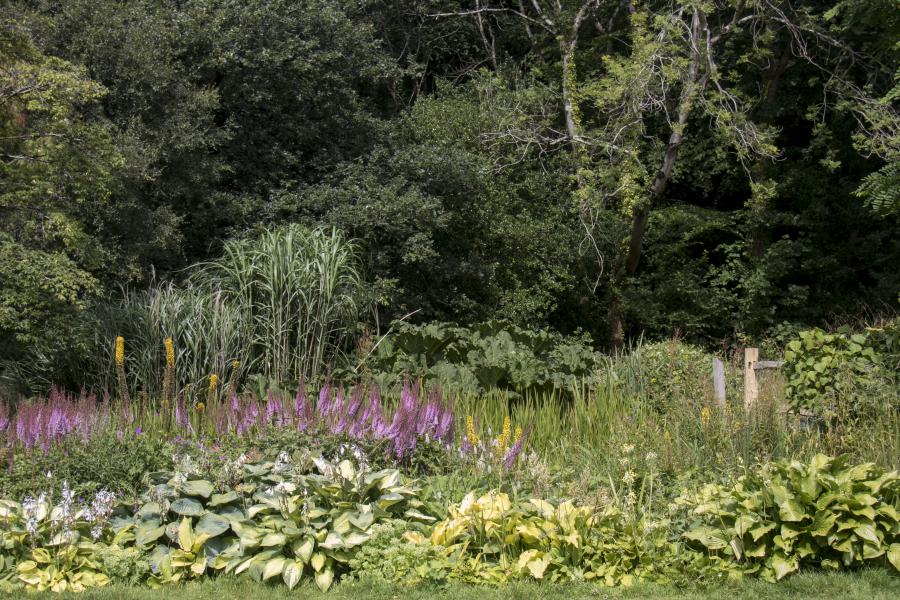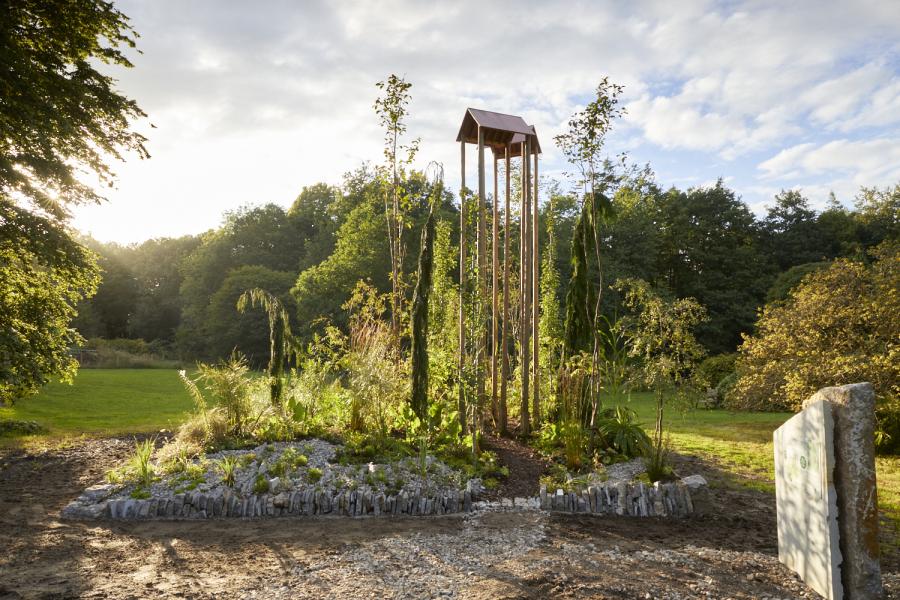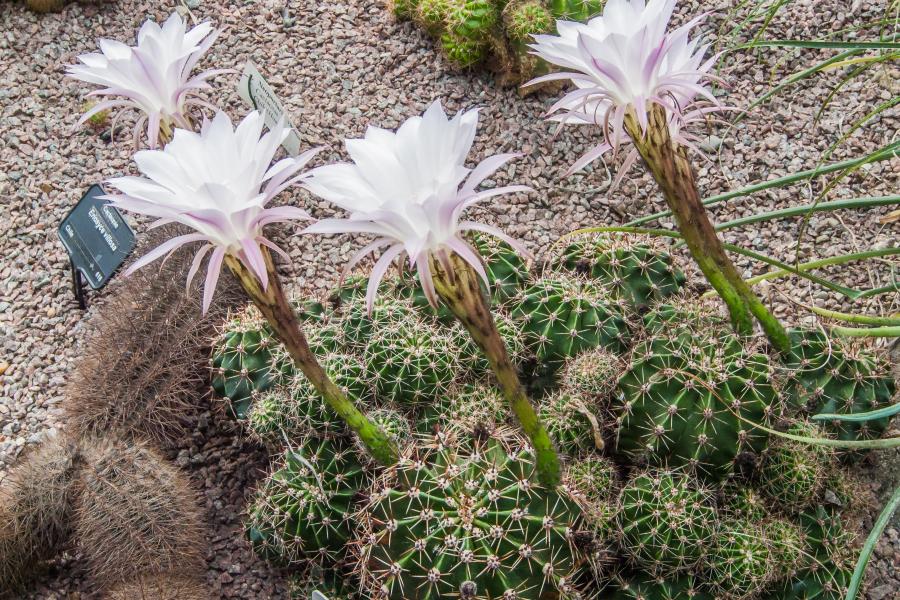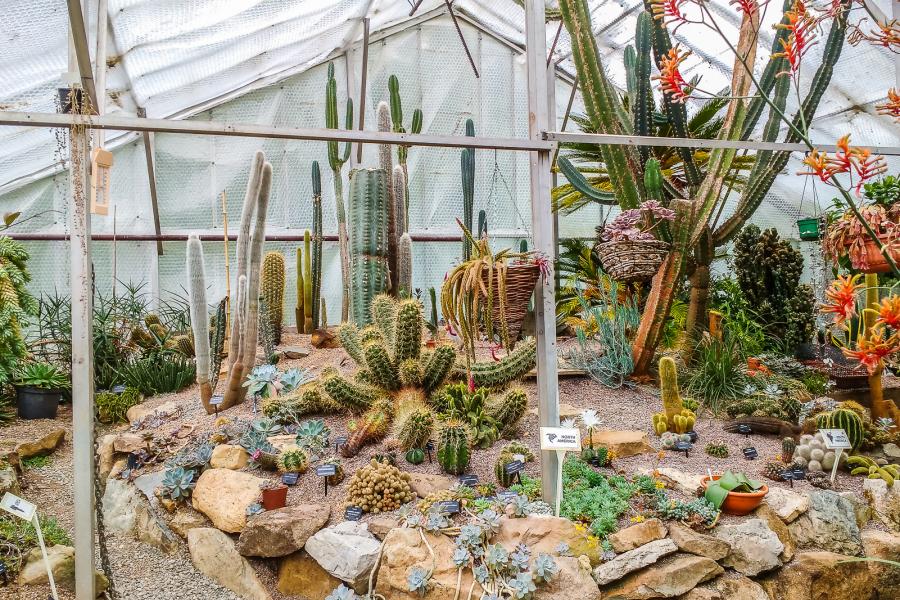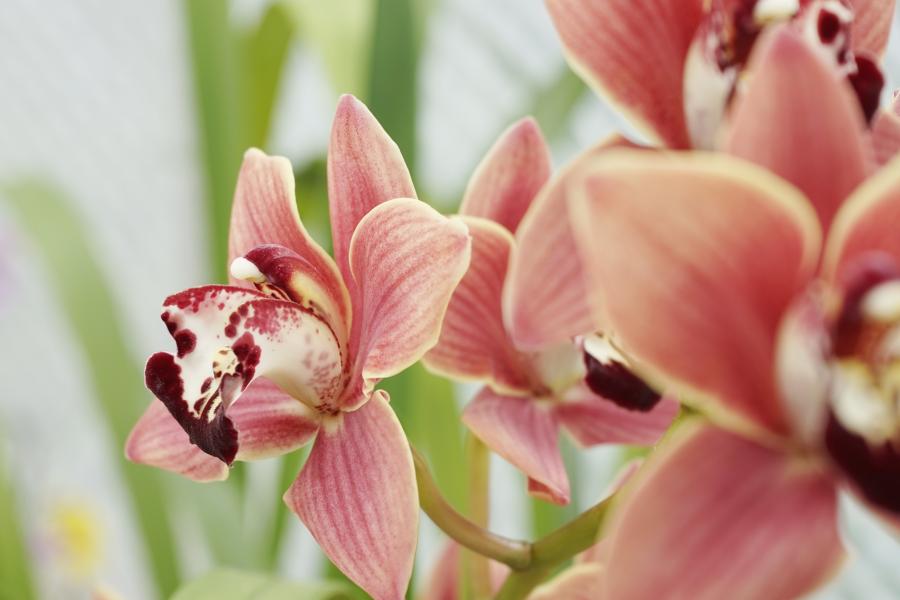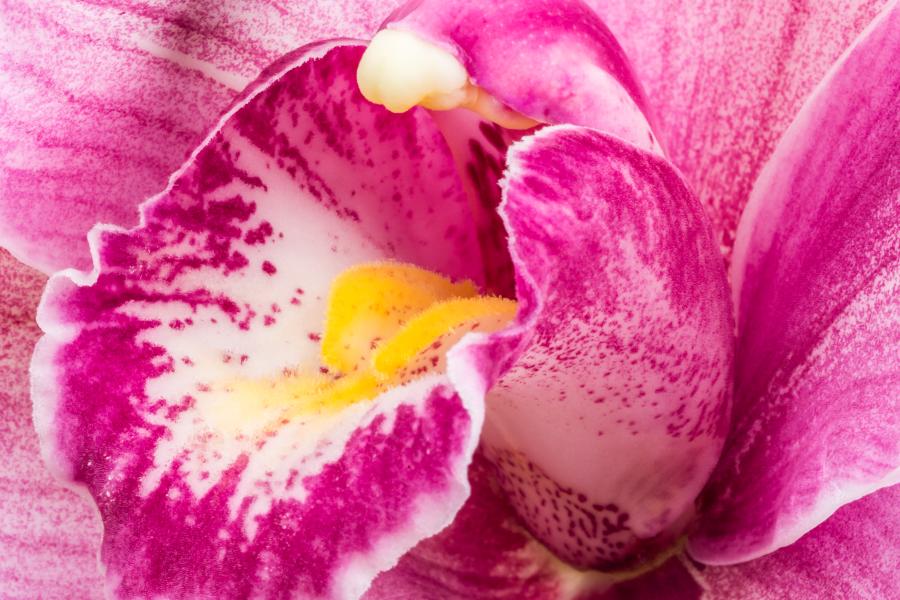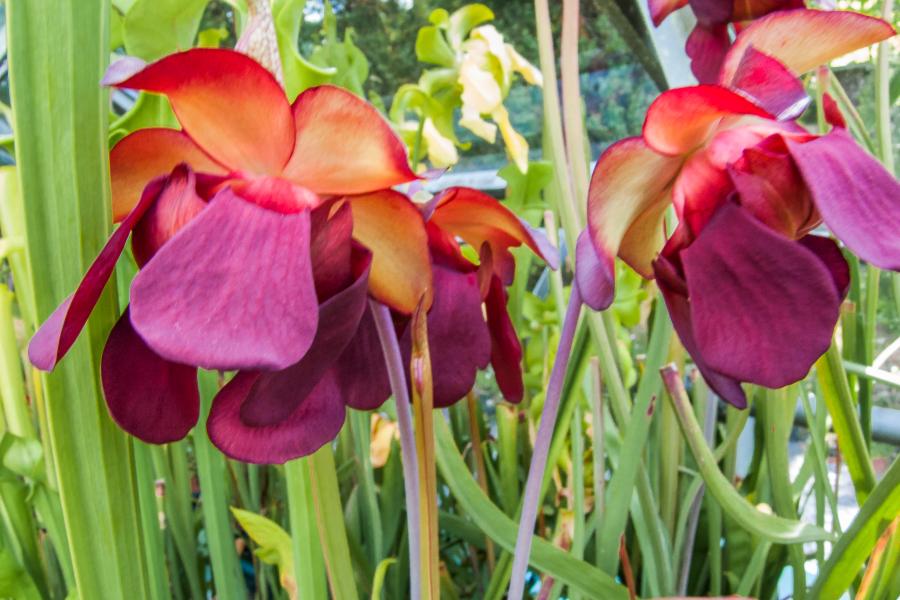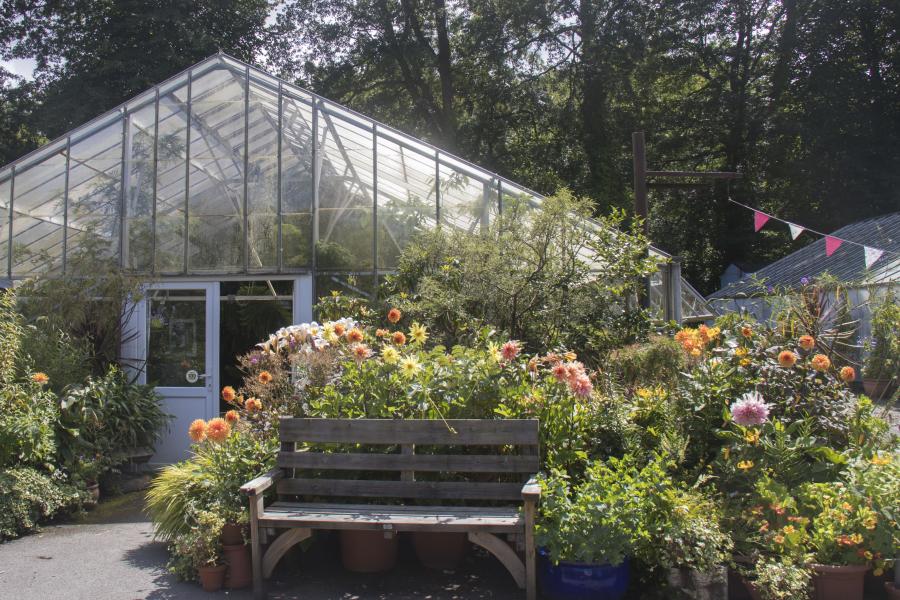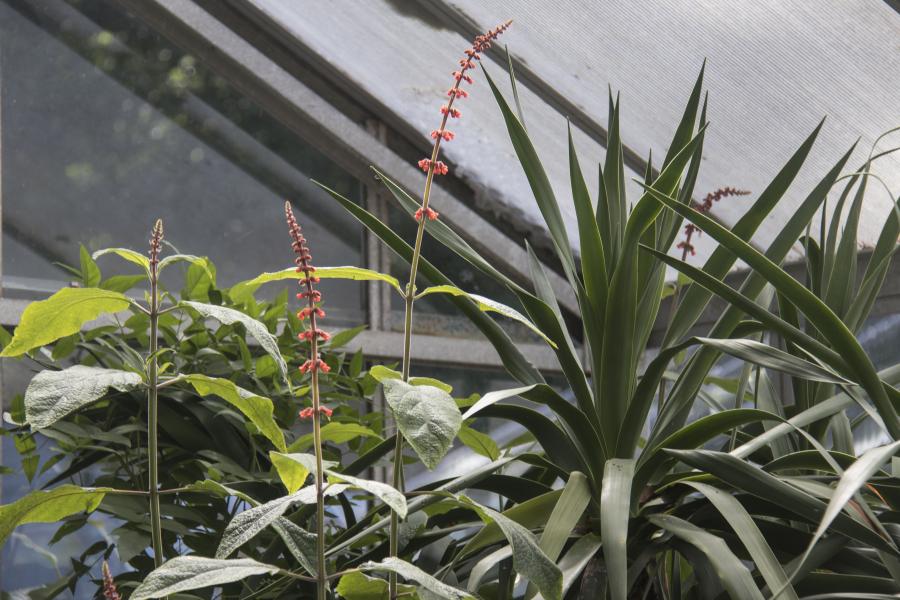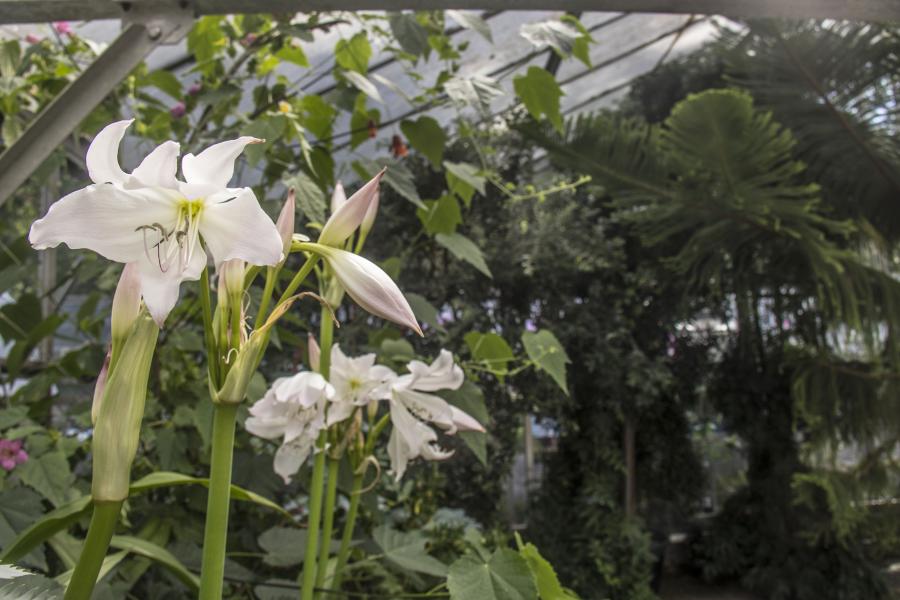GARDENS AND WOODLAND
Wildflower Meadows
Meadows like the ones at Treborth have unparalleled plant diversity, providing the life support for a huge range of wildlife including fungi, bees, flies, beetles, spiders, moths, butterflies, reptiles, amphibians, small mammals, bats and birds. They are also an intrinsic part of our cultural heritage - rich in landscape character, farming, folklore and history.
The meadow plots at Treborth Botanic Garden are among its most biodiverse areas, home to over 150 native plant species along with hundreds of species of fungi and invertebrates. These unimproved grasslands represent one of the rarest and most threatened habitats in the UK.
According to conservation charity Plantlife, six million acres of UK grassland were ploughed for cereal crops during the Second World War, and since then, 97% of traditional meadows have been lost. Today, less than 1% of the UK’s land area is grassland (Plantlife, 2019).
This extraordinary habitat is the product of 6,000 years of interaction between people and the land. Traditional agricultural practices such as hay cutting and livestock grazing, not only created diverse plant communities but are also an integral part of our cultural history.
Species-rich meadows do more than support wildflowers. They provide vital ecosystems for invertebrates and small mammals, and deliver essential services like carbon sequestration, flood prevention through water retention, and habitats for pollinators that benefit agriculture (Plantlife, 2019).
Each year between June and September, we cut and rake the meadow plots to align with the natural seed-shedding period. After mowing the meadows with a push-along brush cutter and tractor mounted cutter, the cut material is left in place for a few days to allow seeds to drop.
Timely removal of the cuttings is essential to replicate traditional hay meadow management. This process maintains low soil fertility, which helps suppress dominant grasses and allows less competitive wildflower species to thrive. While we’ve refined our methods over the years, this remains a labour-intensive task requiring several people over several weeks.
A major recent development in our management approach has been the involvement of local countryside contractors, who use tractors to cut and remove vegetation from the larger meadow plots on the east side of the Garden. The harvested material is taken to local sites including Penrhyn Castle and along the A55 highways to help establish new meadows with locally sourced seed.
As part of our grassland and meadow strategy, we have welcomed a small flock of Manx Loaghtan sheep to the Botanic Garden, a rare breed native to the Isle of Man. The sheep have been brought in to provide a short period of grazing until February. This will have multiple benefits: it will help remove the thatch from the surface of the soil (a major barrier to seed germination), it will keep regrowth of grass after the hay cut under control during an essential period of seed germination in the autumn, and it will bring in a bit more dynamism into the meadows through the creation of bare soil and uneven grazing into the sward. It will also help maintain fertility levels naturally, improving the hay yield (and therefore value) of the grassland.
This approach has required some extra resources to be put in place (fencing, people to undertake regular stock checking, provision of water) but the benefits (for both biodiversity and visitor education and engagement) far outweigh any costs involved. Grazing really is essential for the maintenance of good meadows; as the old adage goes, “meadows make livestock and livestock make meadows”. We are very grateful to the Kehoe Countryside team who have provided us with the sheep and armfuls of knowledge and expertise.
We have also decided to retain a permanent fence around the larger meadows, upgrading from post a rail to more traditional cleft oak fencing (with stock metal when the animals are on site), with a series of gates that we can open so everyone can enjoy the meadows all year. This will give structure to the meadow area when the plots have been cut, and opportunities for more interpretation about our conservation practices.
Though physically demanding, managing the meadows is a deeply rewarding task for both staff and volunteers. It's a privilege to contribute to the annual cycle that results in spectacular wildflower and orchid displays each spring and summer. These well-established plots, untouched by plough or chemical treatments since the 1950s, are thriving. They support around 150 native plant species, including five types of orchid. Across the meadows, over 2000 common spotted orchids thrive. These meadows are also a haven for fungi, birds, amphibians, small mammals, and countless invertebrates.
Bog Garden
Hidden away in a quiet corner of the woodland lies the bog garden. Fed by a natural spring and shaded by trees, it remains lush and damp throughout the year. Once shaped by historic landscaping efforts in the 19th century, the area has largely been reclaimed by nature. Old drainage ditches, now softened by mosses and ferns, help to maintain the garden’s swampy character.
Our new boardwalk invites you to step right into the heart of the bog garden. As you follow its winding path, you pass over boggy ground and ephemeral pools that provide valuable habitat for wildlife, before exiting through a grove of exotic walking stick bamboo. This secluded part of the garden is a perfect spot to slow down and soak up the calming sounds of the woodland.
The Bog Garden is home to a mix of trees, ferns and flowering plants. Damp hollows and slightly drier banks create varied conditions where native ferns like Asplenium, Dryopteris, and Polystichum thrive.
Larger exotics, including Woodwardia unigemmata, Todea barbara and Parablechnum cordatum, form bold stands of foliage, with tree fern trunks rising from the damp ground, to create a subtropical atmosphere
From the Bog Garden, visitors can look across to the Rhododendron collection, where spring and early summer colour complements the surrounding foliage.
Butterfly Border
In 2009, Ann Wood from the Friends of Treborth Botanic Garden (FTBG) created a butterfly border at Treborth. Its purpose was to attract butterflies and other beneficial insects, while also showcasing how a variety of garden plants can support wildlife. Located in the north-east corner of the Garden, the border enjoys a sheltered, sunny spot near the wildlife pond.
Over time, some of the more vigorous plants began to dominate the space, crowding out others from the original design. This prompted plans for a renovation, along with an opportunity to extend the border and reorganize the surrounding area to make maintenance such as mowing easier.
While the value of native plants for supporting wildlife is often emphasized, many garden plants, including non-natives, are also excellent for attracting butterflies and important pollinators. A recent study by the Royal Horticultural Society (RHS) confirms that garden plants can effectively support pollinators. The RHS recommends:
- Planting a diverse mix of flowering plants from various countries and regions
- Prioritizing species native to the UK and northern hemisphere
- Ensuring a continuous supply of flowers throughout the year, regardless of origin, to support a wide range of bees, hoverflies, and other pollinating insects.
Many garden centres and seed catalogues now label plants that are particularly attractive to pollinators. The RHS also promotes its ‘Perfect for Pollinators’ logo to guide gardeners.
The redesigned butterfly border is now wider at the top end and features a crushed slate path at the back for easier access and upkeep. Existing shrubs like Buddleja, which line the nearby woodland edge and are popular with butterflies, will be supplemented with additional pollinator-friendly varieties. A new seating area has also been added, inviting visitors to pause and enjoy the sights of the border and the insects it draws.
A revised plant list based on Ann’s original selection, has been created to lengthen the flowering season and make use of the additional space. Once fully planted, the border and surrounding area will offer blooms from early spring through late autumn. A Mahonia has also been included to provide valuable winter flowers for bumblebees and other insects that may emerge on milder days. Some of the plants, especially annuals, are being grown from seed at the Garden, while perennials and shrubs are being sourced from nurseries.
The Garden is especially grateful to the Students for Treborth Action Group (STAG), who successfully secured funding through Bangor University Students’ Union and allocated it to this project. Student work parties have also been instrumental in providing hands-on help with the renovation. We warmly invite you to visit the butterfly border, watch its progress, and enjoy the array of butterflies and other insects it attracts.
Rock Garden
The rock garden is not exclusively for growing alpines, as it was originally envisaged by its creator Len Beer in the 1970s. Today, following an extensive renovation led by volunteers in the early 2020s, it reflects a more Mediterranean selection of plants, in keeping with the future-proofing necessary to adapt to climate change. Half of it is given over to plants that prefer a neutral or base-rich substrate and is made of limestone blocks and dressed with limestone chippings. This half creates a landscape of domed shrubs and conifers, beneath and around which grow herbaceous plants and bulbs typical of a Mediterranean climate.
The other half is made of sandstone blocks, dressed with blue granite. This retains Rhododendrons from the original planting, but as these succumb to a hotter environment, they will be succeeded by shrubs tolerant of more acidic conditions in warmer climes, including South African heaths, Rock Roses and Lavenders. Shade - once an anathema for the rock garden, but essential in a heating climate - is provided by conifers and smaller trees.
Welsh Herbal Garden
Welcome to the Welsh Herbal Garden, a space rooted in the rich heritage, folklore, and healing traditions of Wales. This garden celebrates the fascinating history of medicinal plants, long used by the people of Wales to treat ailments and enhance wellbeing.
Inspired by the Welsh landscape and crafted using local materials, the garden features two circular seating areas linked by softly winding paths. Raised drystone planters offer both a place to rest and an opportunity to explore the aromatic and tactile planting up close. At the heart of the garden stands a striking slate mural engraved with the garden's logo – a tribute to Celtic symbolism and the native ferns that flourish on site.
The planting scheme is a vibrant storytelling tool, bringing to life the traditions of medieval Welsh healers – including the renowned Physicians of Myddfai (Meddygon Myddfai) – who used plants for remedies that ranged from practical to mystical.
Remedies once included:
- Distilled red rose water for toothache
- Bruised saffron as a sobering tonic
- Feverfew to ease bruises
- Apples to remove warts
- Thyme for colds
- Honey and rosemary to soothe nausea
While some treatments were grounded in early medical insight, others were steeped in legend – such as hart’s tongue to promote chastity or wild clary to ward off envy.
The Legend of Myddfai
In the 12th century, the story begins in the village of Myddfai, Carmarthenshire, where a healer named Rhiwallon began a legacy of herbal medicine. Legend tells of a mysterious lady from a nearby lake who married Rhiwallon and bore him three sons. Though she later returned to the lake, she passed on her knowledge of herbal healing to her eldest son, beginning a lineage of physicians who practiced well into the 18th century.
According to folklore, Prince Rhys Gryg of South Wales once commissioned Rhiwallon to document the medicinal uses of native plants in Welsh, so that future generations could benefit. These writings laid the foundation for centuries of herbal knowledge, some of which was later recorded in the Red Book of Hergest (Llyfr Coch Hergest) – a cornerstone of medieval Welsh literature.
Though the tale of the lady in the lake may be myth, the legacy of the Physicians of Myddfai is real. Their reputation spread across Europe, earning them acclaim for their deep understanding of plant-based medicine.
Ancient Roots, Modern Science
While the garden pays tribute to historic herbal practices, it also highlights the ongoing relevance of plants in modern medicine. In collaboration with colleagues from the School of Medicine, we’re exploring both British and Chinese plants that have played – and continue to play – a vital role in healthcare. Examples include:
- Malaria: Artemisinin from Artemisia annua, quinine from Cinchona (grown in our Chinese Garden)
- Alzheimer’s disease: Galantamine from Galanthus nivalis (snowdrop), which grows widely across the site
- Chronic pulmonary disease: Tiotropium, derived from Atropa belladonna (found in the Rock Garden)
- Pain relief: Capsaicin from Capsicum annuum (chili), and morphine/codeine from Papaver somniferum (opium poppy – grown in the Chinese Garden)
- Parkinson’s disease: Apomorphine, a morphine derivative
- Aspirin: Derived from willow bark – we cultivate various willow species at Treborth
- Cancer treatment: Paclitaxel from Taxus (yew) – one of our native conifers
- Heart failure: Digitoxin from Digitalis (foxglove) – grown in the Rock Garden and being propagated for the Welsh Garden
The Two Dragons Garden Project
The Two Dragons Garden Project is a collaboration between Treborth Botanic Garden, Xishuangbanna Tropical Botanic Garden (Yunnan), and the Royal Botanic Garden Edinburgh, supported by the Confucius Institute at Bangor University and the British Council.
Named for the national symbols of China and Wales, the project aims to deliver innovative training for recent graduates through placements in botanic gardens in both countries. The programme helps participants gain practical experience and supports career development in horticulture and environmental education.
The initiative has fostered strong partnerships between training providers, employers, and botanic gardens, leading to the development of new vocational training curricula. Trainees gain hands-on experience across the partner gardens and apply their skills in real-world settings.
A central feature of the project is the creation of a Chinese Medicinal Garden at Treborth. This space showcases China’s native flora and the ancient practice of traditional Chinese medicine still widely used today. The garden also supports scientific research into the medicinal properties of plants.
Located on the former Trocodendron border, the garden features mature specimens like Malus hupehensis and Aralia undulata. Landscaping began in 2013, transforming the space into three curved sections surrounding a central area for reflection, creative learning, and traditional Chinese exercise practices.
The planting design includes structural and architectural species such as Betula ermanii, Hamamelis mollis, Tetrapanax papyrifer, and Decaisnea fargesii. Slate monoliths that represent mountains, miniature landscapes, and scholar’s stones, were inspired by classic Chinese garden design and donated by Derbyshire Aggregates.
A handcrafted larch moongate marks the garden entrance, flanked by Pinus armandii, reflecting the symbolic pine trees often seen in Chinese gardens. In traditional belief, fungi growing on these pines are thought to promote longevity and health.
Local artists contributed six green oak benches, and a Verdigris lily bowl water feature was added in memory of Ocean Science Lecturer Eilir Morgan.
Planting continues with a mix of dry shade and moisture-loving species, including Sarcococca, Epimedium, Podophyllum, and medicinal ferns. The garden evolves annually, incorporating new Chinese medicinal plants such as dwarf rhododendrons, Cornus, Rubus, and a variety of herbaceous perennials.
Bamboos At Treborth
This collection is long established with the earliest acquisitions dating back to the 1980's and now contains substantial and striking clumps of many species, mainly from SE Asia.
These demonstrate the many attractive variations in the stems and leaves of these giant grasses especially in the new shoots which appear in the spring.
Most of the collection is situated in the North-West corner of the garden with outlying specimens in the Bog Garden and a few in pots around the buildings.
One of the most notable features of woody bamboos is the irregularity of their flowering, frequently over decades or even centuries and then they often die. Because many of the species to be found in UK or European gardens probably descended from a single wild collection they tend to flower in unison. In recent years we have had three species do this and there is a fourth in flower at present.
South African Border
The South African Border was established by Pauline Perry, one of the original Friends of the Garden who had worked for a number of years at Stellenbosch Botanic Garden.
The bed showcases plants not only from the Republic of South Africa but also from Lesotho, Eswatini and Botswana. Some genera are long established in UK gardens such as Agapanthus, Hesperantha and Crocosmia but others are less often seen Eucomis, Ornithogalum and representatives of the Restio family. Many of these would in the past have been considered too tender to grow outside in the UK but it is now recognised that much of South Africa has frost in the winter and material sourced from those areas can thrive in our milder areas.
The aim is to try and have something of interest in flower from late spring to late autumn.
More plants from this part of the world may be seen in one of the beds by the Lab and in the Temperate House.
Welsh Heritage Fruit Orchard
Our Welsh Heritage Fruit Orchard showcases rare native trees like the Denbigh Plum, Bardsey Apple, and Cariad Cherry. These unique varieties have deep roots in Welsh history and have evolved to succeed in our damp, coastal climate.
History and Discovery
An old Victorian cooking apple, going back to at least the 1870's. Named after its unusual shape, rather than its flavour.
Fruit
This is a very early cooking apple. Can be picked in August, the fruit will last until October. Bright green and then turning gold. The crop can be extremely heavy, even on very young trees. The fruit are very large. Excellent for dried apple rings (White and tangy). Cooks to a brisk, light purée.
Pollination group B
History and Discovery
Raised by John Basham & Sons of Bassaleg in Monmouthshire in 1900 from a seedling of Cox's Orange Pippin. This juicy apple was a popular variety and has an intense aromatic flavour. The flavour is said to be at its most exquisite on St Cecilia's Day (Nov 22nd). St Cecilia is the patron saint of music.
Fruit
St Cecilia is a vigorous and heavy cropping tree. Pick in October and use December to March.
RHS Award of Merit 1918
RHS First Class Certificate 1919
Pollination Group B
History and Discovery
A large green cooking apple, long grown on Anglesey. First recorded in the 1600's. It is named because of its unique shape. It cooks to a robustly flavoured, slightly perfumed puree. Needing a little additional sugar. Wrapped in pastry and then baked, it was often eaten as dumplings in the field by agricultural labourers. The fruit keeps for several months in cool storage. The flavour mellows with time to an excellent brisk eating apple, ideal for enlivening salads. Crops Heavily.
Fruit
Ideal for organic cultivation in Wales. Very disease resistant. Pick early October. Use October to January.
Pollination Group C
History and Discovery
Nant Gwrtheyrn on the Pen Llŷn in North Wales was an isolated quarry community accessible only by the sea. A delightful golden russet eating apple with a fascinating fennel flavour was found four years ago in the remains of the quarry manager's garden. Although over 100 years old, the battered old tree still produces sound fruit.
The once derelict buildings of Nant Gwrtheyrn are now restored and are used as a Welsh Language and Heritage centre. The walk down to the village and the sea views are fabulous. Be sure to visit the museum and café.
Fruit
This naturally disease resistant apple is ideal for organic cultivation in Wales. Pick in October, use October to December.
Pollination Group B
History and Discovery
Dates back to the C18th, very popular with South Wales coal miners as the tangy yet sweet juice was particularly refreshing down the pits.
Fruit
Pick and eat in September. It has been used over the years as a popular cider variety making a robust yet sweet early cider, ready for Christmas.
Pollination group B
History and Discovery
Bred by Ian Sturrock and Sons for Mr C. Golan of Plas Tŷ Coch, Caernarfon. The object was to produce a cherry that would do well in the Welsh Climate, i.e. would be: Self-fertile, not prone to cracking in wet years, not suffer from bacterial canker and ripen well in a relatively gloomy spring. Stella was crossed with Napoleon Bigarreau, which was then crossed with a Devon Mazzard. The trees have been tested along the banks of the Menai Strait for the past ten years.
Fruit
Medium sized, sweet, red skinned cherry. Pinked fleshed and very juicy. Picking time (In North Wales) is in early August.
Pollination group: Self-fertile
History and Discovery
First mentioned in 1785. Exactly where in Denbigh remains uncertain. It is the only native Welsh plum to survive. It has large dark-red fruit that are strewn with golden dots. The flesh is sweet and juicy with a good depth of flavour.
Fruit
Excellent when eaten warm and straight from the tree. It is also good for cooking and jam making. The young trees now produced are the first ones available in over 100 years. The handful of remaining trees are remarkably disease free. Our re-introduction of the Denbigh Pum has now led to the formation of the Denbigh Plum festival. Be sure to visit in October! Pick and use in mid-September.
Pollination group: Self-fertile
History and Discovery
Translates as 'Bird's Beak' and found in St. Dogmaels, Pembs, believed to have been planted by the Tiron monks at the abbey for the purposes of cider making.
Fruit
A midseason eating apple with sweet and juicy flesh. It is green skinned with deep scarlet stripes. The top of the apple resembles a bird’s beak which is “pig aderyn” in Welsh. Pig Aderyn also makes an excellent single vintage cider. The Bishop of St David’s is recorded as having criticized the St Dogmaels Monks for their excessive drinking!
Pollination Group B
History and Discovery
Found growing just outside the walls of Conwy Castle. The name Jac y Do (Jackdaw) is a traditional name to refer to those born in the town walls. Many jackdaws can be found roosting around the towns. walls and orchard.
Fruit
Round pale yellow skin with some pink flush and russet. A bittersweet with lots of tannin. A vigorous cropper, falls in late September.
Woodland
The woodland at Treborth Botanic Garden spans around 16 hectares and lies between two iconic bridges, Menai Bridge (designed by Thomas Telford) and Britannia Bridge (by Robert Stephenson) that link Gwynedd with Ynys Môn. It is also part of the Arfon Historic Landscape, as recognized in the Register of Historic Landscapes in Wales.
This area features a rare coastal example of ancient maritime oak woodland, over 400 years old and designated as a Site of Special Scientific Interest (SSSI). It also contains notable calcareous wet birch woodland, along with post-war plantations of oak, ash, and sycamore, some of which are now more than 175 years old. Within this woodland, a thriving Forest School promotes outdoor, nature-based play and learning in collaboration with partners like Coed Lleol and Nature Keen.
The woodland supports a rich variety of wildlife, including breeding red squirrels, a well-established heronry, and numerous species of small mammals, birds, invertebrates, and over 500 species of fungi. It serves as a dynamic outdoor classroom for community engagement, student education, and academic research.
Treborth Botanic Garden has secured £250,000 through the Woodland Investment Grant (TWIG), delivered by The National Lottery Heritage Fund in partnership with the Welsh Government.
The funding will support the restoration and revitalisation of Treborth’s 16-hectare woodland—enhancing biodiversity, improving access, and creating meaningful learning experiences through workshops, training, and events.
Nestled between the Menai and Britannia Bridges, Treborth’s ancient oak woodland is a designated SSSI and part of the Arfon Historic Landscape. It is home to red squirrels, a heronry, diverse wildlife, and over 500 species of fungi, and serves as a hub for education, conservation, and community engagement.
This project will:
- Enhance woodland health and resilience as part of the National Forest for Wales
- Establish conservation zones and improve habitat diversity
- Improve access with new paths, signage, and interpretation
- Support wellbeing through nature-based activities
- Offer hands-on learning in woodland crafts, research, and traditional skills
Workshops, courses, and woodland tours will run throughout the project.
Arboretum
The Arboretum is the wooded strip between the Lodge entrance and the glasshouses, bordered by the road and railway. Once overgrown with self-seeded trees and invasive species like bamboo, cherry laurel, and rhododendron, it has been transformed over recent years. The coastal footpath helped open it up, and thanks to the efforts of volunteers, students and the University Estates team, the area now features beautiful glades and striking tree vistas.
Recent storms have brought further changes, sadly felling some mature specimens, including the Incense cedar (Calocedrus decurrens) and damaging the large ash (Fraxinus excelsior). Fortunately, most affected trees were already in decline.
We have established a tree timeline, showcasing how tree species have arrived in Wales over time. Each species is labelled in Welsh, English, and Latin, with context on its arrival, whether post-glacial, medieval, or 19th-century introductions. A leaflet and website resources will offer further details.
Existing highlights include rare trees like the coffin tree (Taiwania cryptomerioides), sawtooth oak (Quercus acutissima), Hungarian oak (Quercus frainetto), Douglas firs, spruces, and yews, all of which will be preserved and complemented with new plantings over time, as funding and help allow.
In 2015–2016, we planted Roman-introduced species, walnuts, mulberries, and wild pears in cleared areas east of the coastal path car park. Where possible, we use Welsh-provenance trees.
We also hope to enhance spring interest by planting native wildflowers such as bluebells, snowdrops, daffodils (including Tenby daffodils), wood anemones, and primroses, prioritising true wild species over garden cultivars.
The Ponds
Ponds are among the most biodiverse habitats in Britain, supporting 80% of freshwater plant species and numerous animals such as toads, insects, and the birds and bats that feed on them. Sadly, Britain lost up to a million ponds in the 20th century due to agriculture, development, and neglect.
Ponds naturally evolve over time, slowly turning into wetlands and eventually woodland, faster in nutrient-rich lowlands. Despite their simplicity, ponds host complex ecosystems, many of which are only visible under a microscope. They also connect with surrounding environments, supporting species like frogs, dragonflies, and even aquatic moths.
At Treborth Botanic Garden, we are fortunate to have two main ponds and two smaller dipping ponds. These are actively managed to showcase aquatic plants and support biodiversity for both aquatic and terrestrial wildlife.
Located near the Chinese Garden, this lined pond has existed for over 20 years and once featured a variety of native and ornamental plants. However, invasive species especially New Zealand Stonecrop (Crassula helmsii) have disrupted its ecosystem. This plant, introduced by accident, can quickly blanket ponds, crowding out other species. We have had to drain and clear the pond twice to remove it, which also affected native plant diversity.
We have since repaired vandalism-damaged liners and redesigned the surrounding area to discourage further disturbances. A new wetland border has also been developed to support moisture-loving plants and create a more natural buffer.
Built between 2009–2010, the new pond is twice the size of the old one and includes two dipping ponds. Despite using nutrient-poor soil, rapid plant growth led to a dense marsh-like state by 2021. Invasive species Crassula helmsii and Parrot’s-feather (Myriophyllum aquaticum) were also found here.
To restore the pond’s biodiversity, a phased clearance began in early 2022. Volunteers, students, and staff removed invasive plants and opened areas of water to support amphibians, dragonflies, and damselflies. Temporary plant stacks allowed displaced animals to return safely.
This ongoing process will take a few years, with full success only confirmed after two consecutive years free from invasive species. Long-term plans include replacing wooden supports with slate walls and fully remodelling the dipping pond area using clean, low-nutrient soil. Rare plants like bladderwort are being conserved for replanting once conditions stabilize.
In the meantime, regular maintenance will help control nutrient levels and support a rich diversity of pond life at Treborth.
The Size Of Wales Garden
The Size of Wales garden won Gold medal and Best in Category in the ‘All About Plants’ category at the RHS Chelsea Flower show in 2024 and was relocated to Treborth two weeks after the show, recreating the essence of the garden with some tweaks and new ideas to ensure it thrives in its new home here in Wales.
The Size of Wales Garden is inspired by the abundance and rich biodiversity of plant life in tropical forests, while commenting on the devastating consequences of deforestation.
313 plant species have been planted, reflecting the number of tree species that can occur in just one hectare of tropical forest. Slender spires of columnar trees soar skywards. Miniature alpines cluster among the rocks, sprinkled with yellow flowers - the colour of hope.
Finally, a couple of small roofs nestle at the top of gangly posts, calling to mind the precariousness of our comfy existence. This is a garden that aims to leave the viewer dusted in magic, and keen to do more to protect our precious forests.
GLASSHOUSES
Tropical House
Step into a hidden rainforest under glass. The Tropical Glasshouse replicates the warm, humid conditions of tropical forests, with temperatures maintained around 30°C throughout the year. It supports an important living collection of tropical plant species from Asia, Africa, the Americas, and northern Australia, making it a valuable resource for teaching and research.
Here you’ll find important economic crops like black pepper and the Cavendish banana, which regularly produces zero-air-miles Welsh bananas! The planting mirrors typical rainforest structure, with tall species forming a canopy that shades a rich understory of tropical ferns, epiphytic orchids, bromeliads, and carnivorous plants.
Climbers such as Aristolochia labiata showcase fascinating pollination strategies, while a large Ficus aurea demonstrates the complex ecology of strangler figs. Familiar houseplants like Fittonia and Monstera grow alongside rare and endangered species such as the corpse flower (Amorphophallus titanum) and Stanger’s cycad (Stangeria eriopus).
Designed as an immersive teaching environment, the Tropical Glasshouse offers visitors and students a unique opportunity to explore tropical plant diversity, supporting teaching and research in ecology, physiology, systematics, and conservation.
Temperate House
Step into our Temperate House and discover a vibrant collection of exotic and unusual species from temperate regions of Africa, Australia, New Zealand, Asia, and the Pacific Islands.
Glasshouse Highlights
- Cacti and Succulent Collection: Showcasing plants adapted to extreme heat and drought, including a striking succulent mound with African, North and South American species.
- Southern African Bulbs: Thriving on winter rain, these bulbs bloom spectacularly during the Cape’s rainy season (May–July).
- Tenerife Endemics: Featuring rare plants like the Canary Island pine and bell flower, reflecting the island’s unique volcanic ecology.
A Burst of Colour
Enjoy vivid displays from the bird of paradise (Strelitzia reginae), bright pink Bougainvillea, the fiery orange marmalade bush (Streptosolen jamesonii), and an array of orchids, palms, and tree ferns.
Succulents Explained
Succulents store water in leaves, stems, or roots and thrive in arid environments. Our collection includes:
- Leaf Succulents: Like Agave and house leeks (Aeonium)
- Stem Succulents: Including iconic cacti and Euphorbia species
- Pachycauls: Such as the Elephant’s Foot (Dioscorea elephantipes), with thick trunks for water storage
Conservation & CITES
Many succulents are endangered due to habitat loss and overcollection. Treborth supports conservation through education and cultivation, adhering to CITES regulations that restrict international trade of protected species. Plants like the spiral aloe (Aloe polyphylla) are part of our ex-situ conservation efforts to preserve and potentially reintroduce threatened species.
History
The succulent collection began in the 1970s and expanded in 2008 with the construction of the current mound, using sustainable materials. It remains a living classroom for visitors and students alike.
Orchid House
Step into a world of botanical wonder at the Orchid House, home to an extraordinary collection representing species from every continent except Antarctica. With representatives from four of the five orchid subfamilies, our living collection showcases the remarkable diversity in form, colour, and structure found within the Orchidaceae family.
Highlights include orchids from biodiversity hotspots such as the Andes, Costa Rica, the Atlantic Coastal Range of Brazil, the Himalayas, Southeast Asia, Indonesia, the Philippines, Indochina, Taiwan, Japan, and Madagascar. These regions, rich in endemic flora, are reflected in the breadth of our collection.
Dedicated to the memory of Professor Peter Greig-Smith (1922–2003), a globally respected plant ecologist and orchid enthusiast, the collection continues to grow in scope and impact. It serves as a year-round resource for teaching and inspiration, not only for university students but also for artists, naturalists, and visitors of all ages.
Orchids ignite curiosity. As the largest family of flowering plants, their intricate relationships with pollinators highlight their ecological importance and their role in global biodiversity. Many species on display are now rare or extinct in the wild, highlighting the significance of ex-situ conservation.
Whether you're drawn by their scientific intrigue or artistic beauty, the orchids at Treborth offer a captivating glimpse into the world's most diverse and delicate ecosystems.
Criteria for Collection Composition
- Broad spectrum of representative species from all the Tribes, Subtribes, etc. illustrating the huge variety of morphology and habitat. This provides an endless source of material for teaching systematics, anatomy, biodiversity, conservation and ecology.
- Species of both botanical interest and spectacular display.
- Flowers for fragrance - regarded as very important due to this being the plant family with the widest range of fragrances and scents. The type of scent, and the time-of-day release are useful indicators for type of insect pollinator.
- Representative species from all over the world showing geographical diversity. Himalayas through Indo-China and Taiwan, Japan, Australia, Madagascar, Indonesia, Central South and North America, Europe and the British Isles, mainland Africa.
- Species and hybrids of historical interest, such as Darwin’s Madagascan orchid, Angraecum sesquipedale.
- Hybrids, such as Cymbidium and Phalaenopsis, are used for display and teaching. The large, long-lasting flowers are ideal for floral anatomy classes, and demonstrations of the unique pollination mechanism.
Carnivorous House
Carnivorous plants thrive in a wide range of habitats and climates, typically in nutrient-poor environments where few other plants can compete. To survive, they’ve developed ingenious ways to trap and digest prey, supplementing the nutrients they can't absorb from the soil. Some use sticky mucus or oily glues like flypaper, while others have slippery pitfall traps or snap shut mechanisms like the iconic Venus flytrap that catch unsuspecting insects walking across their modified leaves.
Their diet is just as diverse. Tiny bladderworts (Utricularia) feed on microscopic aquatic creatures and nematodes, while butterworts (Pinguicula) trap fruit flies and even airborne pollen. Pitcher plants such as Sarracenia and Darlingtonia attract and digest larger insects like flies and wasps. The tropical Nepenthes species can grow to impressive sizes and have even been found containing the remains of small birds, lizards, and rodents.
At Treborth Botanic Garden, we cultivate over 100 species and cultivars of these fascinating plants. You’ll find tropical varieties in the Orchid and Tropical Houses, while temperate species including some native to the UK, are displayed in the dedicated Carnivorous House.
Cool House Conservatory
Once a glasshouse for cacti, succulents, and later cool-temperate plants, the Cool House Conservatory has been beautifully refurbished. It now showcases an impressive collection of large container-grown gymnosperms, ferns, and other exotic species. Designed as a versatile space, the conservatory also hosts workshops, plant sales, lectures, and meetings.

